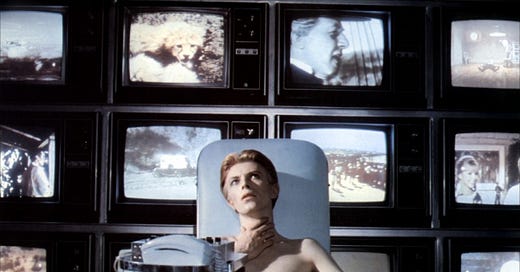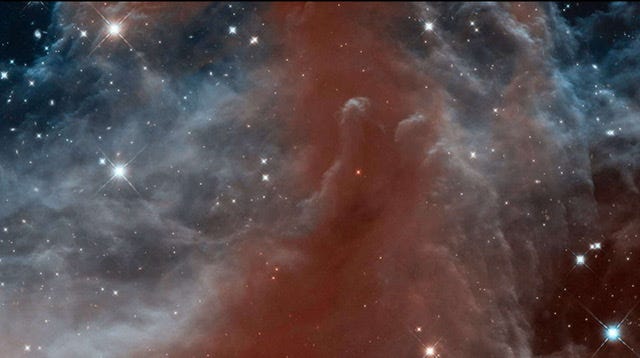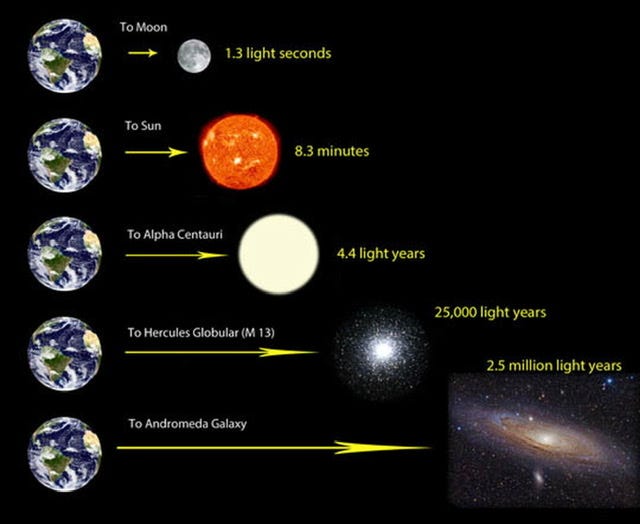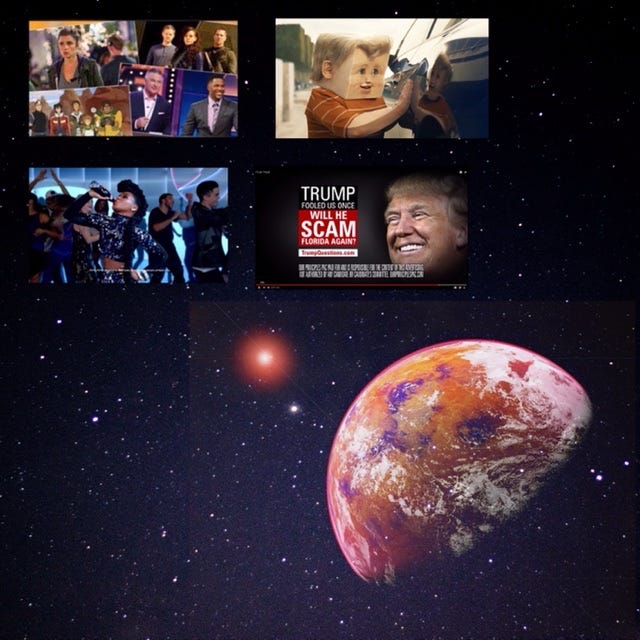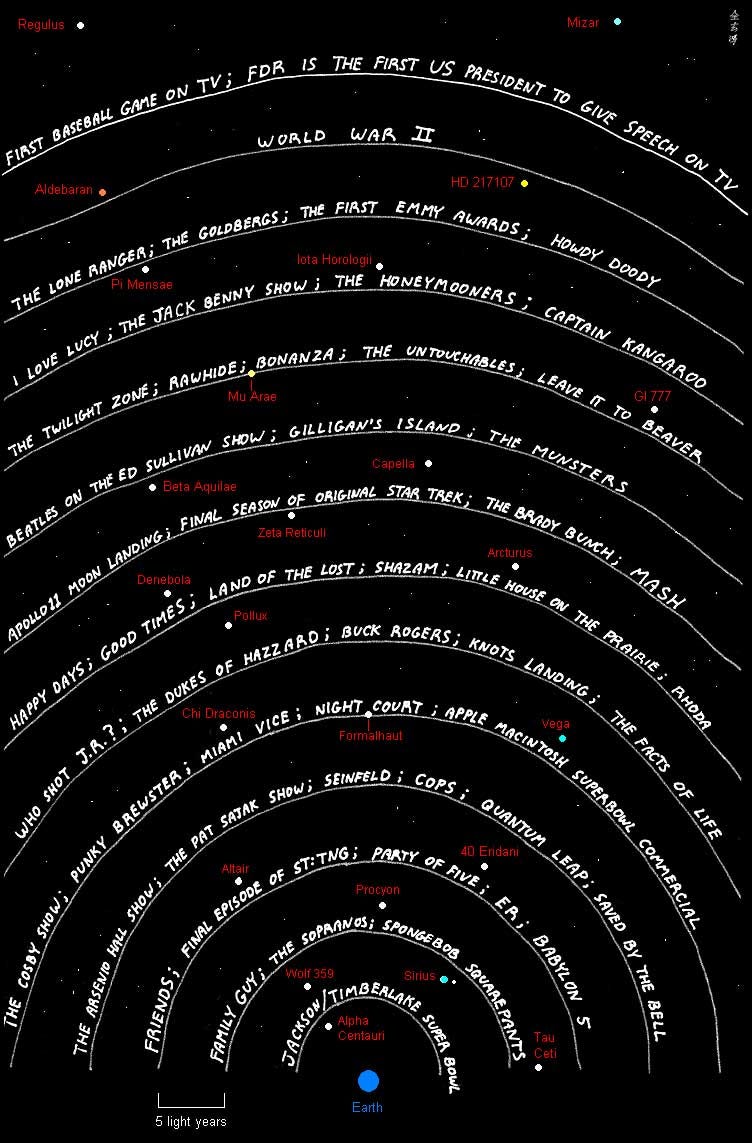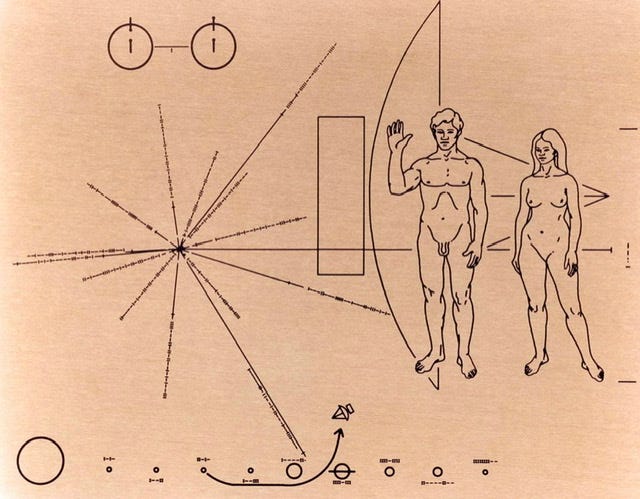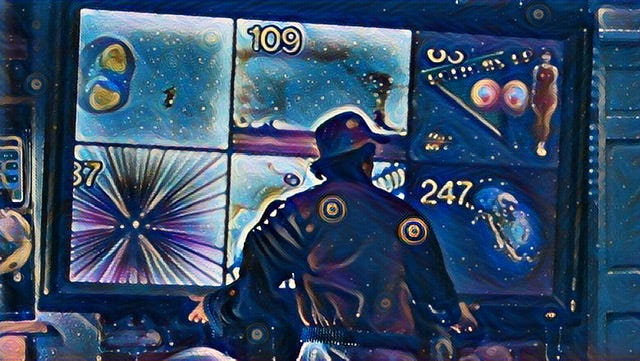"We have been monitoring your signals for years."
It's a standard science fiction device. A mysterious, articulate alien lets the dumbfounded Earthling in on a minor infinite secret. The news that we weren’t special was always a big UFO to swallow. Humans of the Fifties and Sixties worried more about privacy. Now that we know every purchase is tracked, every keystroke is recorded, and Russian junior high students are enjoying our cat pictures, we are resigned to the eavesdropping.
Those hitchhikers of the galaxy were elitist of the highest form. Smug-as-hell Michael Rennie,as the visiting Klaatu in The Day the Earth Stood Still (1951) credited radio with teaching him perfect English. In The Man Who Fell to Earth (1976), David Bowie was attracted by television commercials portraying Earth as a great place to stop for a drink. Other-worldly villains twisted the info from our wavelengths. Quickly, they planned to attack and subjugate a soft, selfish, wealthy world.
Straying into reality, we have all wondered if "they" can really hear or see us? Scientists believe there are probably millions of inhabited worlds out there. “Probably” and “Millions.” What do they know and when did they know it? Do they care about Hoda Kotb or Jimmy Fallon?
The answer is an unqualified, absolutely positive, unshakable maybe.
Electronic transmissions have been leaving our Earth since the invention of radio. Possible communication was limited early on because the ionosphere trapped many AM broadcasts. But an occasional signal "leaked,” giving distant ham radio operators tastes of a golden age spanning from The Green Hornet and Duffy's Tavern to Amos and Andy and Gunsmoke.
FM radio has a better chance of being heard in space, but remember how a hometown station sounds when you get 60 miles into a road trip? The best FM stereo stations in the world--Classic rockers to country to hip hop to public radio and sports talk, Hispanic, religious--aim their invisible signals like waves of searchlights across the sky. There is no ceiling or safety net, just eons of distance. Working together as they would never have in real life, they could be forming an accidental electric flag waving in space.
If those frequencies modulated into a findable signal, alien listeners might be inclined to fiddle around with their dials long enough to receive...television!.
Sound + Vision transmissions emanate from Earth daily at the speed of light. Light speed is 186,282 miles a second, 670,616,629 miles per hour. Earth is eight light MINUTES from the Sun. The light year, for the analog fans, is six trillion miles.
Television as a work-in-progress from many sources, was first tested in the early 1930's. Science communicator supreme Carl Sagan (1934-1996) cringed that Nazi Germany’s Berlin Olympics opening ceremony was broadcast to 41 countries in 1936. Sagan used the irony of Hitler’s being the first image blasted through time and space in his book Contact (1985). President Franklin Roosevelt didn’t appear on television until the 1939 New York World's Fair.
Regular television broadcasting did not begin until after World War II then flourished in the 1950s. A boom of incredible proportions, especially in this country, put a television in nearly every household. In 1950, 104 television stations reached just under four million households. In 1975, those numbers had increased to 949 stations serving sixty-eight million viewers. Television is now accessible to 307.9 million Americans aged 2 and up. Advertising & Media Outlook says 4.23 billion people will watch some television during 2021.
The planet is saturated. But what about the Milky Way?
“FM signals and those of broadcast television travel out to space at the speed of light. Any eavesdropping alien civilization will know all about our TV programs (probably a bad thing), will hear all our FM music (probably a good thing), and know nothing of the politics of AM talk-show hosts (probably a safe thing.)”
-Neil deGrasse Tyson
Alpha Centauri often gets described by astronomers as “our backyard” because it is 4.22 light years away. Nerd science humor. Just for laughs that would mean they are currently in the midst of our 2016 election. But they may be interested in a far different story.
Following three years of observation, the existence of exoplanet Proxima Centuari b was confirmed on Aug 24, 2016. Instead, headlines proclaimed a Trump rally in the Sunshine State, and a poll that showed Clinton leading there by 14%. A possible “we have made contact story” got buried in favor of politics. A new cousin to Earth, complete with a sun-like star and temperatures being favorable for surface water, was not the lead story.
The broadcast halo around the Earth extends out about 75 light years. Within this circle are electronic transmissions of everything that has ever been sent out on terrestrial television, Milton Berle to The Jeffersons, Miami Vice to Freaks and Geeks to This Is Us and beyond. Cable programming doesn’t reach into space unless it goes into syndication and out into the air. Otherwise a barrage of situation comedies, quiz shows, made-for-TV movies, reality clusters, used car commercials, news, weather, sports--everything--leaves the Earth 24/7/365.
The signals travel, but as of now neither NASA or Elon Musk has come up with a way to physically reach the stars. Pioneer 10, launched in 1972, is plodding along at a mere seven miles a second. At that rate it will reach the realm of Proxima b in about 80,000 years. It carries a message from President Jimmy Carter and a plaque drawn by Linda Salzman Sagan.
For a 1978 issue of Science, the Department of Astronomy at the University of Washington in Seattle stopped short of saying the aliens could pick up our programs, but considered the possibilities. Their reasoning was that if a star the size of Sirius, eight light years away and larger than our sun, shows up here as merely the brightest star in the sky, how strong might a transmission of Gilligan's Island be on their end?
Using a model of 2,191 television stations worldwide to study the frequency and intensity modulations, they decided that extraterrestrial viewers might be able to tell quite a bit about us, but making sense out of all those weak signals may also cause headaches on a planet that has yet to develop acetaminophen.
"It is, of course, conceivable that advanced technical civilizations could have very high intensity space surveillance radar systems, for astronomical or military contingencies." -Carl Sagan, 1979
Earth's television "signature" is strictly limited to ourgalaxy, The Milky Way. Chances of the World Series broadcasts reaching Andromeda, 2.2 million light years away, are fairly nil unless of course some enterprising Andromedans have strained to invent a specific signal booster. It’s a stretch for those of us who remember positioning rabbit ears to pick up stations 40 miles away.
In 1992, the discovery of the first exoplanet, or planet not of our solar system, was discovered. Astronomers Aleksander Wolszczan and Dale Frail announced to a Sir Mix-A-Lot Mariah Carey world that they had found planets in orbit around the pulsar PSR B1257+12, a whopping 2,300 light years from Earth.
Now, as then, for this particular leap of faith, we will stay with the stars in our own neighborhood, although that neighborhood has sprawled considerably.
Coming next in Part II: “Who is watching what when and why?” The Intergalactic TV Guide, Television of the Stars!
l
l

